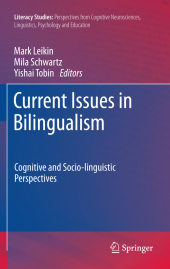 Neuerscheinungen 2014Stand: 2020-02-01 |
Schnellsuche
ISBN/Stichwort/Autor
|
Herderstraße 10
10625 Berlin
Tel.: 030 315 714 16
Fax 030 315 714 14
info@buchspektrum.de |

Mark Leikin, Mila Schwartz, Yishai Tobin
(Beteiligte)
Current Issues in Bilingualism
Cognitive and Socio-linguistic Perspectives
Herausgegeben von Leikin, Mark; Schwartz, Mila; Tobin, Yishai
2012. 2014. x, 266 S. 15 Tabellen. 235 mm
Verlag/Jahr: SPRINGER NETHERLANDS; SPRINGER, BERLIN 2014
ISBN: 9400799284 (9400799284)
Neue ISBN: 978-9400799288 (9789400799288)
Preis und Lieferzeit: Bitte klicken
Current Issues in Bilingualism focuses on the language situation in Israel -- a country where Hebrew and Arabic are official languages, English is an academic and political language, and Russian, Amharic, etc., are spoken by immigrants -- to illustrate concepts applicable in a broader scope.
As populations become more mobile, so interest grows in bi- and multilingualism, particularly in the context of education. This volume focuses on the singular situation in Israel, whose complex multiculturalism has Hebrew and Arabic as official languages, English as an academic and political language, and tongues such as Russian and Amharic spoken by immigrants.
Presenting research on bi- and trilingualism in Israel from a multitude of perspectives, the book focuses on four aspects of multilingualism and literacy in Israel: Arabic-Hebrew bilingual education and Arabic literacy development; second-language Hebrew literacy among immigrant children; literacy in English as a second/third language; and adult bilingualism. Chapters dissect findings on immigrant youth education, language impairment in bilinguals, and neurocognitive features of bilingual language processing. Reflecting current trends, this volume integrates linguistics, sociology, education, cognitive science, and neuroscience.
Introduction by Mark Leikin, Mila Schwartz, and Yishai Tobin .- Part I. Language and Literacy in Multilingual Society. Chapter 1. Relevance of the Linguistic Coding Difference Hypothesis to English as an Additional Language of Literacy in Israel by Janina Kahn-Horwitz, Richard L. Sparks, and Zahava Goldstein . Chapter 2. Literacy Reflexes of Arabic Diglossia by Elinor Haddad . Chapter 3. Multilingualism Among Israeli Arabs, and the Neuropsychology of Reading in Different Languages by Zohar Eviatar and Raphiq Ibrahim .- Part II. Academic Achievement of Children Coming from Immigrant Families. Chapter 4. Cognitive, Language, and Literacy Development in Socio-Culturally Vulnerable School Children: The Case of Ethiopian Israeli Children by Esther Geva and Michal Shany . Chapter 5. Second Generation Immigrants: A Socio-linguistic Approach of Linguistic Development Within Framework of Family Language Policy by Mila Schwartz . Chapter 6. Understanding Language Achievement of Immigrants in Schools: The Role of Multiple Academic Languages by Tamar Levin and Elana Shohamy .- Part III. Multilingual Acquisition and Processing. Chapter 7. Adjective Inflection in Hebrew: A Psycholinguistic Study in Speakers of Russian, English and Arabic Compared with Native Hebrew Speakers by Iris Alfi-Shabtay and Dorit Ravid . Chapter 8. Verb Inflections Indicators of Bilingual SLI: Qualitative vs. Quantitative Measurements by Sharon Armon-Lotem, Galit Adam, Anat Blass, Jonathan Fine, Efrat Harel, Elinor Saiegh-Haddad, and Joel Walters. Chapter 9. Procedural and Declarative Memory in the Acquisition of Morphological Knowledge: A Model for Second Language Acquisition in Adults by Sara Ferman and Avi Karni . Chapter 10. Reading L1 and L2: Behavioral and Electrophysiological Evidence: A Comparison between Regular and Dyslexic Readers by Zvia Breznitz and Liat Fabian . Chapter 11. Identification of Grammatical Functions in Two Languages by Mark Leikin and Elina Ritvas


